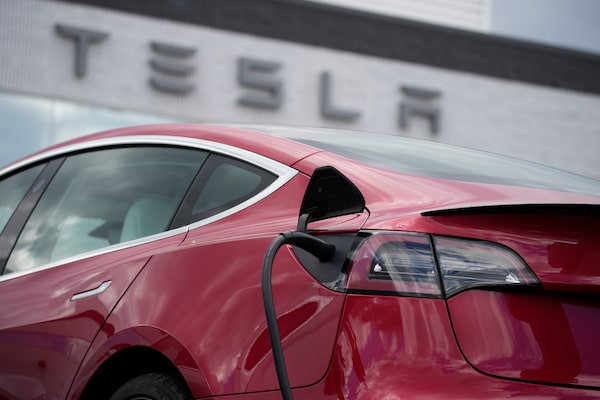
A 2021 Model 3 sedan charges at a Tesla dealership.David Zalubowski/The Associated Press
Electric vehicles aren’t just buzz anymore.
In 2021, one in every 20 new cars registered in Canada was a battery electric vehicle or plug-in hybrid.
In a KPMG survey, 68 per cent of Canadians who are planning to buy a new car in the next five years say they’re considering either a BEV or hybrid.
With interest surging, we had more EV questions than ever in 2021.
A few years ago, most electric car questions touched on range – and worries that there wasn’t enough.
But this year, readers mostly asked about what it’s actually like to live with an EV.
Here are the top EV questions you sent us in 2021:
What do I need to know about public chargers?
With various networks, different plugs and different rates of charging, EV chargers can be confusing.
Relax, it’s “less complicated than it might seem,” said Michael Stanyer, program co-ordinator with Plug In BC.
Do I need to install a 240-volt outlet at home?
You can charge any BEV with a normal 120-volt household outlet, but it could take a day or two to get from empty to full.
A 240-volt outlet, the kind used for clothes dryers, can do it overnight.
But unless you’re driving long distances every day, you can probably get by without one.
Should I avoid charging to 100 per cent?
Some EV owner’s manuals say to avoid charging to 100 per cent to save the life of the battery. But don’t worry too much if you regularly charge to full, an expert said.
“The auto manufacturers do have smart systems in place that don’t let it [actually] charge to 100 per cent or deplete to zero,” said Greg Keoleian, director of the Centre for Sustainable Systems at the University of Michigan.
Why aren’t charging ports on the same side on every BEV?
With no rules on where charging ports have to go, it’s up to car makers to choose sides. But several couldn’t say why they’d chosen driver side or passenger side.
While GM said its customers like the driver side because it reminds them to unplug before taking off, no BEV will let you drive away with the plug attached.
Can I call CAA to charge my EV if I’m stranded?
In most of Canada, you’re still stuck getting a tow to the nearest charger if your EV battery runs out.
It’s not clear how often this actually happens. For instance, Volkswagen said cases where its roadside assistance have had to tow an EV are “extremely rare.”
These days, most new BEVs boast a range of at least 300 kilometres and warn you if you don’t have enough juice to make it to your destination.
Can I drive a PHEV without the gas engine kicking in?
Plug-in hybrids let you drive as an EV for anywhere from 24 to 98 kilometres, depending on the model, before the gas engine kicks in.
But, on most, there are times where the gas engine kicks in anyway, even on a full battery.
How much PHEV range do I actually need?
If you’re planning to drive your PHEV in EV mode as much as you can, figure out how much range you’ll really need.
“If it was me, I would think about my typical daily drive – if your commute is 40 kilometres round trip, you’d want at least that much range,” said Cara Clairman president and CEO at Plug’n Drive, a not-for-profit that promotes electric vehicles. “[You] wouldn’t want to dip into gas for your commute or local errands.”
Should I worry about stale gasoline in a PHEV?
If you’re mostly using the battery in your PHEV, the gas could go stale if it sits in the tank for a few months.
But on most PHEVs, “you’ll end up running the engine anyway,” said Steve Elder, an automotive instructor at the British Columbia Institute of Technology (BCIT).
“If you only ever go back and forth to the grocery store, it’s possible that the engine may not [ever kick in],” Elder said.
Editor’s note: An earlier version of this article stated in 2021, one in every 20 cars registered in Canada was a battery electric vehicle or plug-in hybrid. In fact, it is one in every 20 new cars.
Have a driving question? Send it to globedrive@globeandmail.com and put ‘Driving Concerns’ in your subject line. Emails without the correct subject line may not be answered. Canada’s a big place, so let us know where you are so we can find the answer for your city and province.